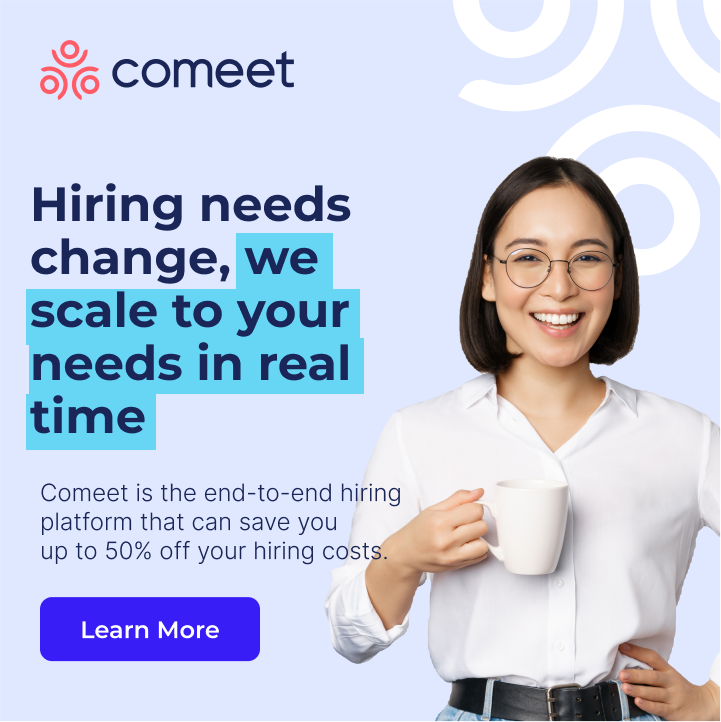A recession or even the specter of economic uncertainty can be a difficult time for any company looking to stay ahead, and it’s natural to want to focus on cost-cutting measures and preserving resources. That might mean putting a hold on hiring until business picks up again. But your recruiting department can still be productive even if you aren’t actively hiring.
When times are lean, most companies focus on cost-cutting and short-term gains. However, many HR practitioners need to realize that using a challenging economic outlook to reassess their recruiting efforts can enhance their organization’s overall performance during these difficult times.
There are always methods you can use to bolster the effectiveness of your company’s recruiting, even when direct hiring is outside the priority. Here are nine recruiting initiatives your company can do during a recession.
Review and update your job descriptions
A recession is an excellent time to review and update your job descriptions to ensure they accurately reflect each role’s responsibilities and qualifications. This can help you attract top candidates when ready to hire again and allow your existing team members to understand their roles and responsibilities better.
More than ever, candidates are looking for clarity of purpose in their job roles. Fine-tuning your job descriptions helps you provide this. Consider consulting with current employees and managers to get their input on what a successful candidate for each position would look like. This can help you create more targeted and accurate job descriptions that will attract the right candidates when you are ready to start hiring again.
Research and build relationships to build your talent pipeline
You can still research and build relationships with potential candidates even if you aren’t ready to hire. This can include reaching out to professionals in your industry on LinkedIn, attending industry events and networking with other professionals, and keeping an eye on job boards and social media for potential candidates.
A company can’t thrive without talent. Once you’re able to hire, you can move forward with the candidates you’ve already fostered a relationship with. Even if you cannot move now, you can always solidify your network with targeted outreach.
By building relationships with potential candidates now, you’ll be in a better position to connect with candidates when you are ready to start hiring again. These connections can also help you stay up-to-date on industry trends and get valuable insights into the job market.
No matter what’s going on in the economy, your company needs to be able to attract the best talent. A recession is not an excuse to stop attracting candidates; it’s more important than ever. Performing an honest analysis of your talent pipeline strategy is critical to your overall talent acquisition efforts.
Here are some best practices for creating and executing a talent pipeline strategy:
- Define what you want from your talent pipelining program. Do you want to find passive candidates? Do you want them fast? Are there educational or training requirements? What are the specific skills you’re looking for?
- Identify your audience. Once you know what kind of talent pipeline will help your business grow, think about who those people are and where they hang out online or offline. That will help shape where and how often recruiters need to reach out with their message. For example, LinkedIn may have interest groups filled with candidates to who you could appeal.
- Make sure employees are on board with the new plan. Make sure everyone understands why this new approach is necessary so they feel supported when participating in cold outreach, social media campaigns, and blogging activities that may require additional time outside regular working hours.
Review your company’s benefit package
Candidates aren’t just looking at the job you want to hire them for; they’re also considering the entire benefits package you can offer. They want to know what joining your team will mean to their personal and professional life and how you can differentiate yourself from your competitors.
A recession is an excellent time to review and update your company’s benefits and perks to ensure they are competitive and attractive to potential candidates. This can include health insurance, retirement benefits, paid time off, and other perks like flexible scheduling or remote work options.
Consider surveying your current employees to get their input on what benefits and perks are most important to them, and use this information to inform your decisions. By offering a solid package of benefits and perks, you’ll be more likely to attract top candidates when you are ready to start hiring again.
Examine your recruitment process
You’ll also want to see how you can improve your recruitment process. If you’re not busy hiring people, you have an opportunity to map out what that looks like for candidates. How smooth is it for them? Where are you losing candidates?
A recession presents an opportunity to update your recruitment process to ensure that it is efficient and effective. This can include streamlining your application process, improving your job postings, and investing in tools and technologies to help you find and assess candidates more effectively.
You can measure your current success and recommend improvements by consulting with your team and other stakeholders to get their input on what fixes can be made to your processes. By making these updates now, you’ll be better positioned to attract top candidates when you are ready to start hiring again.
Perform a retrospective analysis of your candidate experience
Analyzing your candidate experience is a subset of improving your overall recruitment process. Improving your candidate experience is a must for high-impact recruiters. However, this can be tricky if you don’t have a guiding set of principles to direct your efforts.
In general, candidates that apply for a job want the following:
- Clear communication about their status in the hiring process. Keeping candidates updated is essential, even if it’s just to check in and say there is no update. Ironing out your communication procedures for candidates when you’re not hiring makes it more seamless when you have a steady influx of dialogue.
- A reasonable amount of time to get back to them with news. It’s best not to keep candidates waiting, so figuring out how to shorten this process is critical. Top talent tends to have options, which means it makes sense to move fast when there’s news.
- An accurate picture of what will happen next in their journey through the company’s recruiting funnel or cycle. Establish a practice of ending candidate communications with the next steps. Who will they talk to next? What can they expect? Guide them through the encounter.
A company can analyze and improve its talent candidate experience by collecting and analyzing data on every step of the candidate’s journey from job posting to offer acceptance.
You can gather this data by surveying candidates about their experience, analyzing application and acceptance rates, and tracking time-to-fill metrics. Based on this feedback, a company can identify areas for improvement and implement changes to the recruitment process, such as simplifying the application process, improving the consistency of communication with candidates, and offering a more personalized and positive candidate experience.
Hearing from candidates and responding to what they’re telling you will only help strengthen your effectiveness as a recruiter. Put yourself in the candidate’s shoes – by empathizing with their needs and concerns, you can craft a better experience and increase the likelihood of hiring them.
Invest in employee development and retention
If you’re undergoing a hiring freeze, there isn’t a better time to focus on employee development and retention. What can you do to ensure your current employees feel valued and see the benefit of continuing to work for your organization?
Development and retention can include training and development programs, mentorship opportunities, and other initiatives to help your current employees grow and thrive.
Doing this shows your employees you care about their growth and will help them individually. It will also allow them to build their skills – making them more valuable as high performers that can help your team.
Investing in your current team can improve morale, boost productivity, and reduce turnover, ultimately saving your company money in the long run. And by providing your employees with opportunities for growth and development, you’ll be more likely to retain top talent and avoid going through the recruitment process again.
Audit your employer branding
Employer branding is the process of enhancing a company’s reputation in the marketplace. Employer branding is all about telling your potential candidates why they should apply to work for your organization.
The first step in creating an employer brand is to audit your current employer brand attributes. You can ask your staff or management team what they feel are their organization’s strengths and then compare those answers with what you know about other companies’ brands. Are they similar? How do they differ? You may also want to reach out to some outside sources, such as recruiters or potential employees who have worked at other places, and ask them these same questions so that you can get an unbiased perspective on how well employers are perceived within the industry.
Clarify your company vision
High-impact hiring doesn’t happen by accident. It requires you to clearly understand your company’s mission, define your company’s values and vision, and ensure everyone in the company understands the concept.
Recruiting in a recession can prove challenging because candidates are more selective than ever. If you want to attract top talent who will contribute to your success, make sure they know what makes you different from other companies they could join. Your recruiting process should be aligned with these goals:
- Establishing a strong brand identity. It’s not only your customers who care about your brand. Your employees want to work somewhere with a well-defined mission. A strong brand identity clarifies that.
- Getting out there and marketing yourself effectively. Expressing your brand and vision on the proper marketing channels helps spread your message to the right people at the right time.
- Making sure potential candidates understand why they should work for you. Finally, your vision should align with the value proposition you offer incoming candidates. This is where you separate yourself from other companies looking to hire the candidate. It’s where the mission, benefits package, and overall culture should all align to point to a great place to work.
Update your applicant tracking system
Every recruiting department needs some tool to manage their applicants. An applicant tracking system (ATS) fills this role, and ensuring it’s functioning well is an excellent activity for a hiring freeze.
A company can update its Applicant Tracking System (ATS) by researching and considering different ATS options that align with its recruitment needs and budget, importing and cleansing data from its current system, implementing the new ATS and properly training employees on its use, and regularly maintaining and updating the system with new features and integrations that can improve the overall recruitment process.
Don’t wait to improve your recruiting process
In a down economy, you want to make improvements before you’re in a hiring cycle. There’s no point in waiting for the perfect opportunity before you begin improving your recruiting process, employer brand, and ATS.
Overall, just because you aren’t hiring during a recession doesn’t mean your recruiting department has to be idle. By focusing on things like reviewing and updating job descriptions, building relationships with potential candidates, updating your benefits and perks, improving your recruitment process, investing in employee development and retention, and other valuable efforts, you can stay productive and prepare for the future
Hiring the right talent is critical to your organization’s success, no matter what the economy looks like at any given moment. It can be a long, arduous journey that takes time and resources, but it’s worth it. When you invest in your recruiting process and look honestly at your current operations, you’re investing in your business and its future growth.
If you’re looking for a proven solution to help you derive the most value out of your recruiting efforts during a recession, look no further than Comeet’s ATS. Leverage our technology to make your recruiting as effective and efficient as possible.





























